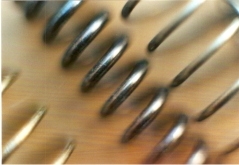10 tips to know about springs
Springs: even if we do not want to take place of thorough and exact texts and sources, but rather to arouse curiosity, let us summarize some tips of practical purpose about the magical world of the elastic components so called springs.
We define a spring be a component, made of metal and with geometrical precise datas , which task is usually to exert a reaction proportional to the deformation (normally also big values) to which it is subjected.
The stiffness of the spring is the increase of the force which the spring itself exerts when is subjected to a unit of deformation.
Regarding the springs manufactured by coiling the wire, it is significant to remind, for example, that from the identical metal wire, stiffer or more flexible springs can be obtained simply changing some geometrical datas.
Different sorts of springs exist:
- the compression springs have a shape suitable to oppose the shortening of their length with respect to the free length;
- the tension springs have a shape suitable to oppose the lengthening of their length with respect to the free length;
- the torsion springs have a shape suitable to oppose the rotation of their ends with respect to the free position.
Regarding an helical compression spring with circular wire, the stiffness is in inverse ratio both to the number of active turns and to the third power of the medium coiling diameter.
Furthermore the stiffness is proportional to the fourth power of the diameter of the wire.
Regarding an helical compression spring with circular metal wire, the internal maximum shear stress is proportional both to the external force required for the deformation and to the medium coiling diameter, and it is in inverse ratio to the third power of the diameter of the wire.
In order to keep the elastic behaviour for life, the maximum shear stress inside the spring must be lower than the safety limits.
Taking all these and other factors into consideration is not an easy job for designers of springs who must installed them in their equipments.
As a function of the working environment and of the loading conditions of the spring, either the type of material is chosen , and the visual, dimensional and functional features which are inserted into the quality control plan.
The spring is usually manufactured using various machines with the method of the cold forming.
At the end of the forming and of the secondary operations (i.e. the hooks-shaping or the ends-grinding) a stabilization heating treatment is carried out.
The spring so manufactured, in conformity with the plan, is ready for the usage in its field of application.
 fields of applications
fields of applications
